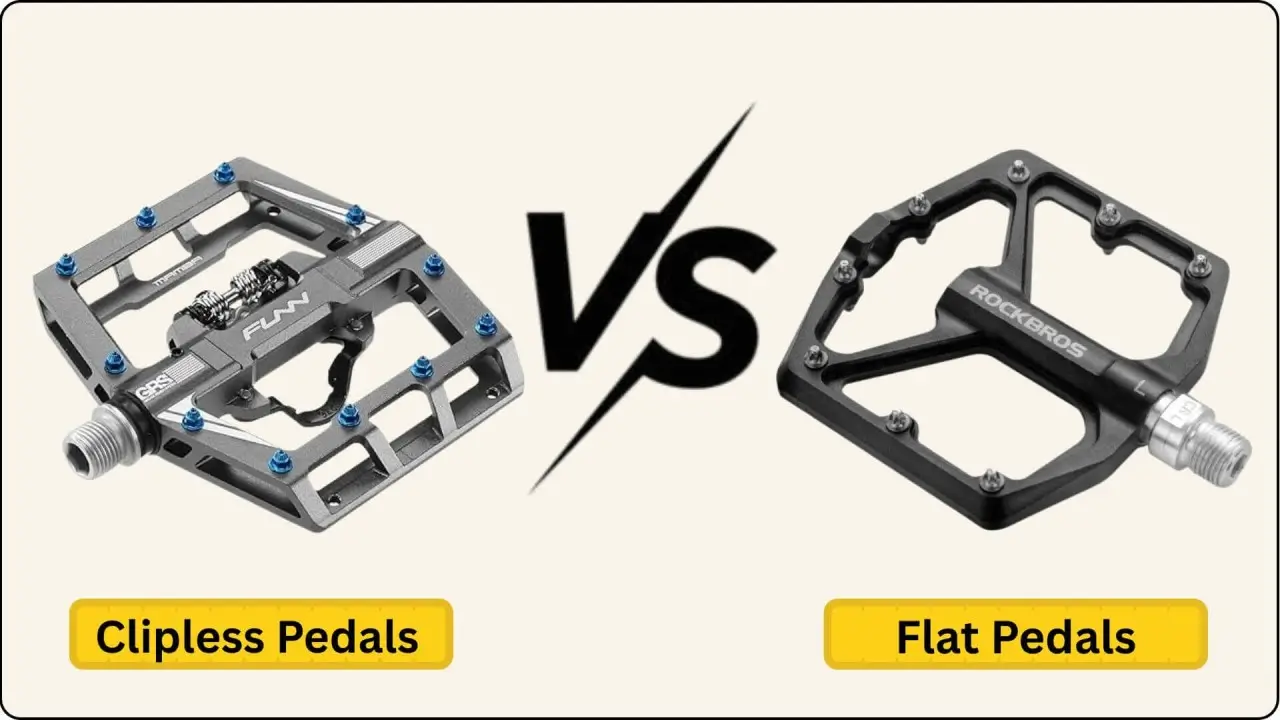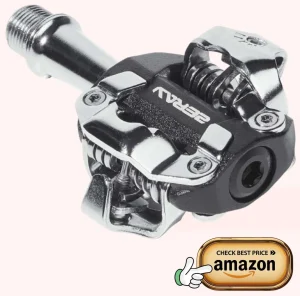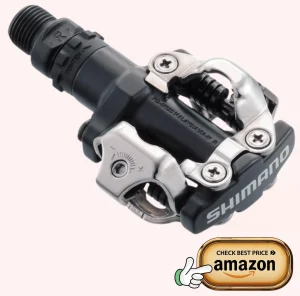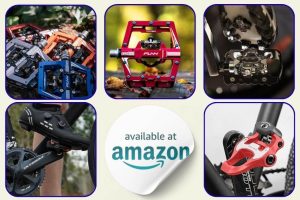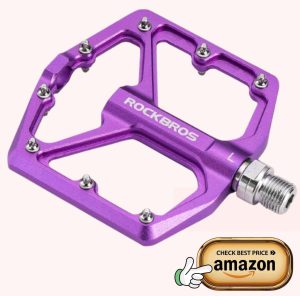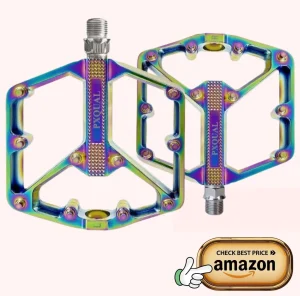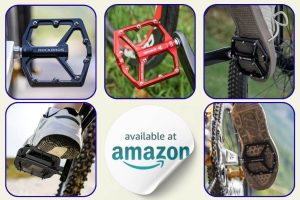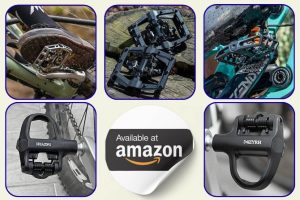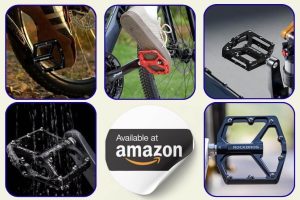I ride often in Portland, Oregon, where wet streets and steep hills test my bike. Flat pedals felt easy, but I slipped more than once in the rain. Clipless pedals gave me power, yet stopping in traffic made unclipping tough. After years of city rides and weekend gravel loops, I’ve used both. Here’s what I learned comparing clipless vs. flat pedals in real rides.
Are Clipless Pedals Good?
Yes, clipless pedals can make a real difference. When I first tried them, I saw right away that my foot stayed in the same spot every time. The cleat-and-pedal system kept me steady and gave me more control on climbs and sprints.
They’re not plug-and-play, though. You’ll need cycling shoes with cleats. The setup took a little time, but once I had the ball of my foot over the spindle, the ride felt smooth and stable.
The big win was pedaling efficiency. Instead of just pushing down, I could pull up too. On long rides, this saved energy and kept my cadence even.
The learning curve is real. My first week came with a few clumsy stops, even a slow fall at a red light. But practice fixed that. Soon, unclipping with a quick heel twist became second nature.
With time, clipless pedals also improved my riding skills. My strokes got smoother, and I felt more in tune with the bike. On rough roads, that locked-in feel made a big difference in stability.
What I Like
- Locked-in feeling: My feet never slipped, even on wet roads. This gave me confidence on climbs.
- Better power transfer: Pushing and pulling improved my pedaling efficiency, especially on long rides.
- Skill growth: Clipless pedals forced me to refine my form. My strokes became smoother with time.
What Could Be Better
- Learning curve: The first rides feel tough, and beginners may fall once or twice.
- Required shoes: You need cycling shoes and cleats, which adds to the cost.
- Maintenance: Pedals and cleats need cleaning and lube. In the U.S., dust and road salt make this even more work.
Recommendation
I suggest clipless pedals if you want to grow as a rider. They shine for road cyclists, long commuters, and anyone training on hills or racing. In the U.S., they’re great for long rides and hilly terrain where efficiency and control matter.
If you’re brand new or just riding around town, flats or dual pedals might be easier at first. But once you learn clipless, they feel like a game changer—you may wonder how you ever rode without them.
Are Flat Pedals Good?
Flat pedals are a solid pick if you want freedom, control, and ease. I’ve used them for short rides in town and on rough trails. In both cases, they gave me trust. Nothing locks you in. You step on, push, and roll away.
That freedom makes flats great for learning skills or riding tricky ground. I like how fast I can move my foot. If I need to dab, shift, or jump off, it feels smooth.
Shoes are another plus. I’ve ridden in skate shoes, sneakers, and even boots. No need for special gear. Still, sticky soles grip much better. This is useful in the U.S., where many riders use one bike for both work and play.
Flat pedals also fit any budget. Basic ones start at $20. Top alloy or titanium models can pass $200. I’ve tried both. The high-end pedals last longer and grip harder, but even cheap ones work fine for casual rides.
Grip on rough ground depends on three things: shoe tread, pedal shape, and rider skill. Dropping my heels and keeping my weight steady helps me stay put. And when I step off, I’m in normal shoes—no awkward walk.
What I Like
- Freedom and ease: I can move my foot or bail out in a snap.
- Any shoe works: I’ve even used sneakers with no issue.
- Fits any budget: From cheap to pro, there’s a good match.
What Could Be Better
- Shin scrapes: Sharp pins can bite. Pads help, but it still stings.
- Less power: On long climbs, flats waste more energy.
- Grip varies: Regular shoes slip. Sticky soles shine.
Recommendation
I suggest flats for new riders, commuters, and trail fans who want control and comfort. They shine on U.S. trails, where roots and rocks require quick moves.
If you ride on roads or long distances, clipless pedals may suit you better since they save energy.
For me, flats are best when I want control and ease more than speed. If you’re not sure, start with flats. They’re safe, simple, and you can switch later.
Detailed Comparison: Clipless vs. Flat Pedals
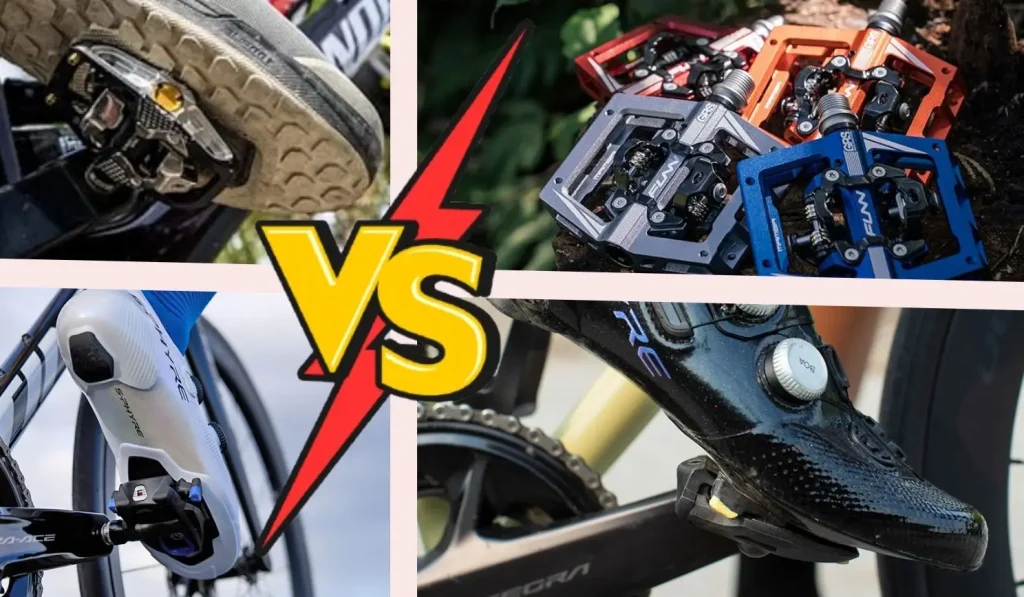
I’ve used both clipless and flat pedals, swapping them based on the ride. Each has its perks. What works best often depends on the trail, the bike, or even my mood.
Foot Attachments: Clipless vs. Flat Pedals
With clipless pedals, shoes lock into cleats. This gives a solid link, great for climbs. Flats use pins or texture to grip your shoes.
In my rides, clipless feels firm but takes time to learn. Flats are easy: step in and go. If my foot slips, though, sharp pins can cut my shins.
- Clipless: 8/10
- Flats: 7/10
Maneuverability: Clipless VS Flat Pedals
Here, flats take the win. I can move my feet, dab on a turn, or bail fast. Clipless needs a twist to unclip, which can feel slow in a rush.
On trails, I felt freer with flats. But once I learned clipless, I could unclip faster than I thought. Still, flats feel more natural when the ground gets rough.
- Clipless: 6/10
- Flats: 9/10
Footwear Compatibility: Clipless vs. Flat Pedals
Clipless requires cycling shoes with cleats. That means more cost and less comfort on the bike. Flats let me ride in sneakers, boots, or casual shoes.
In the U.S., I often ride to the store or town, and flats are easier. For longer rides, clipless shoes feel built for the job.
- Clipless: 7/10
- Flats: 9/10
Cost: Clipless vs. Flat Pedals
Clipless pedals and shoes can get pricey. A mid-range set runs $150–$250. Flats are cheaper. Simple ones cost under $20, while top alloys reach $200.
From my own buys, flats felt easier on the budget. Clipless lasts a long time once you invest.
- Clipless: 7/10
- Flats: 8/10
Control on Rough Terrain: Clipless vs. Flat Pedals
This one is close. With clipless, I stay stuck to the bike on rocks and roots. It feels strong. With flats, I can shift or drop a foot quick, which helps in loose dirt.
I found that shoes and skill matter more with flats. Good shoes make them almost as firm as clipless.
- Clipless: 8/10
- Flats: 8/10
Performance: Clipless vs. Flat Pedals
Clipless gives better power, most clear on climbs. Flats shine in short bursts and tech moves where freedom counts more.
For racing or long rides, I
How I Test: Clipless vs. Flat Pedals
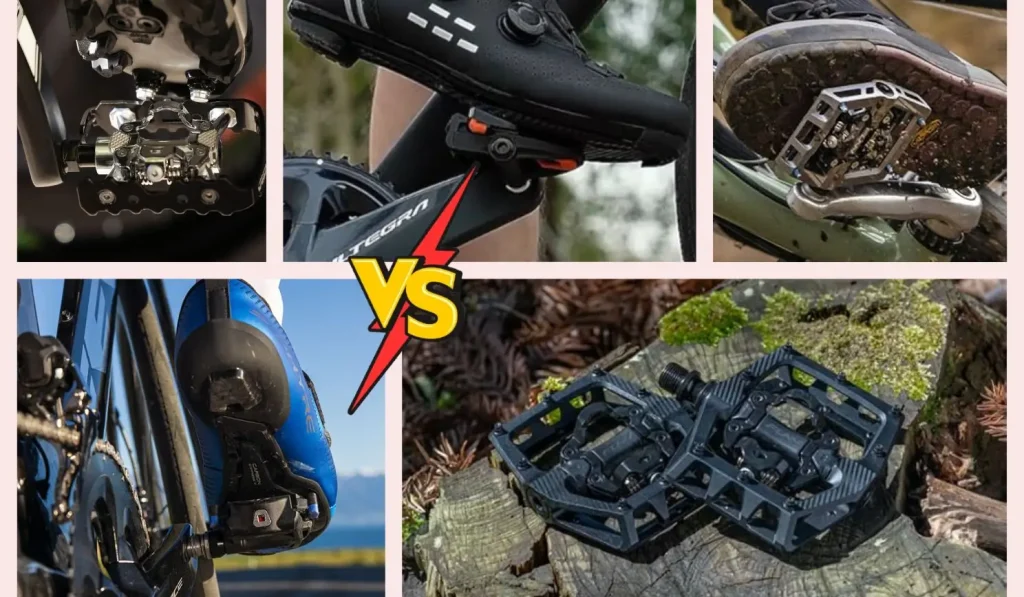
I test pedals as both a coach and a rider. My goal is simple: find what works in real rides. Each section shows how I run my checks and what I learned.
Test Goals & Audience Mapping: Clipless vs. Flat Pedals
Before each test, I set clear goals. I ask: who is this for—commuters, racers, or trail riders? Then I list key needs like control, ease, and walkability.
Test Subjects & Sample Design: Clipless VS Flat Pedals
When I can, I test with a mix of riders. I include beginners and skilled racers. If I ride solo, I repeat runs to mimic different rider types.
Equipment & Setup (Keep It Standard): Clipless VS Flat Pedals
I use the same bike and swap only the pedals and shoes. I record cleat settings, pin length, and pedal tension. Tires, gears, and suspension stay the same.
Test Routes & Scenarios (US Contexts): Clipless VS Flat Pedals
I ride loops in the city, on climbs, and on tech singletrack. I choose routes that match U.S. scenes—wet Northwest streets or dry desert trails.
Objective Metrics & Measurements: Clipless VS Flat Pedals
I take time laps and track cadence and power when I can. I count slips, unclips, and re-engagements. These numbers give hard proof of the differences.
Subjective Metrics & Rider Feedback: Clipless VS Flat Pedals
After each run, I score comfort and control from 1–10. I jot notes on confidence and fatigue. Feelings matter for real-world riding.
Protocol Design & Experiment Validity: Clipless VS Flat Pedals
I randomize pedal order for each test day. I added warm-up and fixed rest times. This cuts bias and keeps results fair.
Variables to Isolate & Test: Clipless vs. Flat Pedals
I change one factor at a time—tension, pin length, or shoe sole. I test wet vs dry, soft vs. stiff shoes. This shows which factor matters most.
Durability & Maintenance Testing: Clipless vs. Flat Pedals
I log the miles and check the wear on pins, cleats, and bearings. I test salt spray for winter commutes. I note how easy each pedal is to service.
Safety Checklist & Risk Mitigation: Clipless vs. Flat Pedals
I wear a helmet, gloves, and pads on tech runs. I set up safe bail zones for quick dismount drills. I teach riders to unclip before timed laps.
Data Analysis & Presentation: Clipless VS Flat Pedals
I show averages and spreads for each metric. I pair video to confirm slips or unclips. Charts stay clean so the gaps are clear.
Scoring & Verdict Method: Clipless VS Flat Pedals
I weighed metrics by rider type. Commuters give more weight. Racers get power and efficiency. I state weights so my scores stay clear.
U.S.-Focused Considerations: Clipless vs. Flat Pedals
I note spare part access in U.S. shops. I track wear in Northeast salt and PNW rain. I also mention U.S. shoe brands and sizing tips.
Solo Reviewer Quick Protocol & Checklist: Clipless vs. Flat Pedals
If you test alone, swap only pedals and randomize the order. Run four laps per pedal on the same loop. Log time, slips, and a short confidence score after each run.
Solo Reviewer Checklist
- Use the same bike and tires.
- Warm up 10–15 minutes.
- Randomize: CLIP / FLAT / CLIP / FLAT.
- Do four timed laps per pedal type.
- Run two emergency dismount drills per pedal.
- Do a 200 ft walk test after each set.
- Log time, power, slips, and notes.
- Take photos of pedal and shoe wear.
FAQs for Clipless vs Flat Pedals
What are the main differences between clipless and flat pedals?
Clipless pedals lock your shoes in place for steady power and control. Flat pedals let your feet move freely and make quick stops simple.
Are clipless pedals better for long rides than flat pedals?
Yes. Clipless pedals work well for long rides. They boost efficiency and cut foot fatigue. Flats give more freedom but feel less secure.
Which is safer: clipless or flat pedals?
Both are safe. Clipless feels tricky at first, but once learned, it adds control. Flats are easy for beginners and make fast stops simple.
Do I need special shoes for clipless vs flat pedals?
Yes, clipless pedals require cycling shoes with cleats to clip in. Flats work with almost any shoe, but sticky soles give more grip and comfort.
Which pedal type is better for city commuting?
For city rides, flats are often best since stops are frequent. Clipless works too, but it takes practice when riding in traffic.
